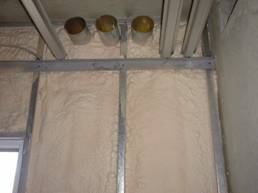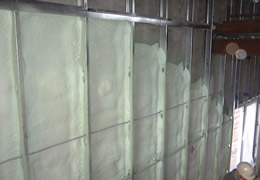What Foam Do I Ask For? / How Do I Know If I Received What I Asked For?
You must realize that there are hundreds of formulations that are called "Spray Polyurethane Foam" and they are designed to be used in hundreds of applications.
For installation in your house or building you want a product which meets the National Standard CAN/ULC S705.1 Standard for thermal insulation - spray applied rigid polyurethane foam, Medium density - Material – Specification . The Building Code references this standard and even where there is no Building Code, many insurance companies require material that would meet this standard or their coverage or rates may change on the for the building.
This foam is a rigid cellular plastic which has a nominal density of 32 kg/m³. This is NOT open cell foam or what is referred to as ½ pound foam. Open cell foam can be squeezed by hand and medium density cannot.
To be sure that the product offered to you meets the standard; ask for a CCMC Evaluation Report Number. The CCMC Evaluation Number is 12380-R. The CCMC Evaluation Report is available at http://irc.nrc-cnrc.gc.ca/ccmc/registry/07/216/12380_e.pdf
Also the product is required to be "easily and uniquely be identified on the job site" by the CAN/ULC S705.1 National Standard. Currently the manufacturers use color to identify their product. Products that meet the CAN/ULC S705.1 Standard include Demilec - Heatlok 0240, Airmetic 0223 and Polar Foam 7300. The colour chosen by the manufacturer to identify their product on the job site for Heatlok 0240 and Airmetic 0223 is green. The colour for Polar Foam 7300 is peach.
Typical colors on the job site are:


Installation Requirements
The CAN/ULC S705.1 National Standard requires that the spray polyurethane foam material be installed in accordance with the CAN/ULC S705.2 standard for Thermal insulation – Spray applied rigid polyurethane foam, medium density – Application.
Detailed requirements for spray polyurethane foam, including physical properties, labelling, limitations, etc can be found in the National Standard which can be purchased from Underwriters Laboratory of Canada. (www.ulc.ca)
This is extremely important for you to understand as spray polyurethane foam is "site-manufactured". The contractor purchases two different liquid components and combines these two components under heat and pressure as it is being installed. The material is generally in a liquid form as it attaches itself to the substrate and then the material "foams-up" to aproximately 30 times the orginal volumn.
There will be a layer or "skin" at the substrate level that will be fully reacted spray polyurethane foam but will not be foamed. Depending on substrate and the temperature of the substrate, this layer would be between 1 to 3mm. There will also be a final "skin" on the surface of the spray polyurethane foam. If this skin must be removed for any reason, it is not a problem as the National Standard requires that the outside skin is removed before the testing on the product is done. If the skin is left on, all physical properties listed in the test report will be met.
The CAN/ULC S705.2 Application Standard lists a number of requirements for the manufacturer (seller of the two liquid components ), the contractor (the corporation who has the contract to perform the installation ) and the installer (the worker who actually sprays the components to form spray polyurethane foam on the job site ).
The CAN/ULC S705.2 Application Standard sets forth requirements for environmental conditions suitable for spraying, substrate requirements, installation requirements, daily testing of the installed products and documentation requirements.
Full details of the installation requirements can be found in the National Standard which can be purchaed from Underwriters Laboratory of Canada. (www.ulc.ca)
If you want to ensure that the proper product is used and it is installed properly, you can simply require that the contractor be licensed by the SPF Quality Assurance Program used by CUFCA. To find a contractor who is licensed or to confirm that a contractor is licensed, visit our Find a Contractor page. During the installation, you should check the web site to ensure that the contractor has maintained their license during the installation period. You may want to include the requirement for the contractor to be licensed at time of bidding and during the installation period.
The Licensed Contractor is required to use installers that are trained and certified under the SPF Quality Assurance Program used by CUFCA. Each installer is issued a plastic photo-identification card every July 1. The installer is required to carry this card with him during the complete installation period.
A sample card is:

In summary, make sure that the product which will be used meets the National Material Standard (CAN/ULC S705.1) and is installed in accordance with the National Application Standard (CAN/ULC S705.2) by a Licensed Contractor who uses Trained and Certified Installers.
If you have any questions on the product, the installation or any application issues contact the CUFCA office at (866) 467-7729 or fax your question to (877) 416-3626 or send then by email to cufca@cufca.ca.
